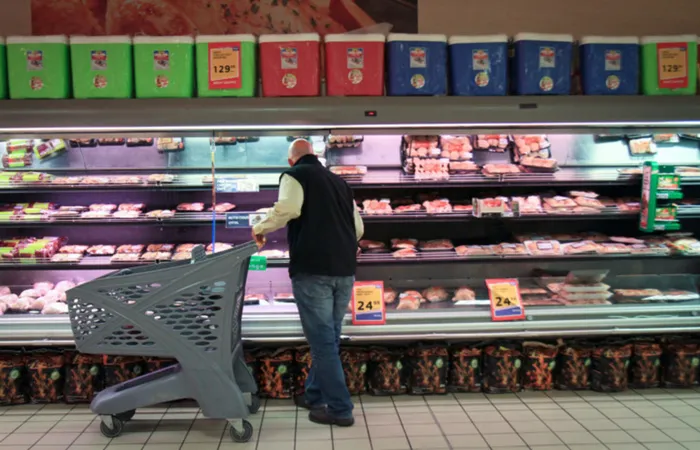Inflation edges up to 3.4% in September as meat prices surge on Foot and Mouth Disease
CONSUMER PRICES

Stats SA chief director of price statistics, Patrick Kelly, said meat inflation surged to 11.7%, the highest annual rate since January 2018, when it reached 13.4%.
Image: Bloomberg
South Africa’s annual consumer inflation ticked up slightly to 3.4% in September from 3.3% in August, according to Statistics South Africa on Wednesday.
The monthly change in the Consumer Price Index (CPI) was 0.2%, with increases largely driven by higher prices in transport and restaurants and accommodation.
While several categories saw faster price growth, inflation eased in food and non-alcoholic beverages (NAB), alcoholic beverages and tobacco, and household furnishings and maintenance.
Stats SA chief director of price statistics, Patrick Kelly, said meat inflation surged to 11.7%, the highest annual rate since January 2018, when it reached 13.4%.
"While month-on-month increases for beef products have slowed, prices do remain high. Stewing beef, for example, rose 32.2% year-on-year, but showed no change month-on-month," Kelly said.
"Other meat categories are also feeling the heat. The annual rates for pork and lamb accelerated notably in September. Chicken inflation is also rising, albeit more gradually. IQF chicken portions climbed to 5% from 4.4% in August, boosted by a 1.1% monthly increase."
Nedbank economist Busisiwe Nkonki forecast inflation to trend gradually higher around 4% by the end of the year, because of base effects and elevated meat prices.
Nkonki said the persistence of foot-and-mouth disease and slow vaccination progress will keep meat prices high for longer, adding that even with vaccination efforts, it will take time for farmers to restore their herds to pre-outbreak levels.
"Nonetheless, the upward pressure on food prices will be contained by favourable weather conditions, which have boosted this season's field crop harvests, and softer global food prices. Electricity prices are also a concern. Nersa’s approval of tariff hikes of 12.7% for 2025/26 and 8% for the following two years will filter through to services inflation," Nkonki said.
"However, lower fuel prices will help offset the inflationary effects of rising food and electricity costs. We expect fuel prices to be kept in check by ample global supply and subdued demand."
Nkonki said although inflation is expected to rise, it will remain relatively muted, averaging 3.3% in 2025. Thereafter, she said they expect inflation to rise to an average of 4% in 2026, before gradually moderating to 3.4% in 2027.
This comes as the South African Reserve Bank (Sarb) Governor Lesetja Kganyago on Tuesday said South Africa’s inflation outlook has now stabilised, with the bank projecting inflation to average 3.4% in 2025, 3.6% in 2026, and 3% by 2027.
Dr Elna Moolman, head of South Africa macroeconomic research at Standard Bank Group, said the latest CPI reading was broadly in line with expectations.
“Consumer inflation came in at 3.4% year-on-year in September, relative to 3.3% in August. Core inflation, which excludes volatile food and fuel prices, was slightly higher than expected at 3.2%,” Moolman said.
“While inflation is higher than the Reserve Bank's aim of 3% trend inflation, it remains lower than aggregate income growth, with the expansion of real or inflation-adjusted incomes then still providing support for consumers.”
Reza Hendrickse, portfolio manager at PPS Investments, said inflation remains well-anchored and consistent with the Sarb expectations.
“This month’s CPI print confirms that inflation indeed remains well-anchored. The environment validatesthe Sarb’s cautious hold stance, in contrast to market expectations that continue to price in furthergradual easing into 2026,” Hendrickse said.
“For investors, disinflation underpins a constructive outlook for interest ratesensitive assets, while bolstering the rand’s relative appeal.”
Koketso Mano, senior economist at FNB, said inflation is likely to rise modestly in October due to higher fuel prices and seasonal food costs.
“We see headline inflation lifting to 0.3% month-on-month and 3.8% year-on-year in October,” Mano said. “Nonetheless, inflation should remain below 4% over the next year, supported by subdued oil prices, a stronger rand, and weak domestic demand.”
Mano added that inflation is expected to hover around 3.5%, with risks tilted downward, especially if government reinforces its 3% target through policy and budget guidance.
BUSINESS REPORT